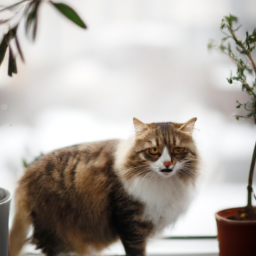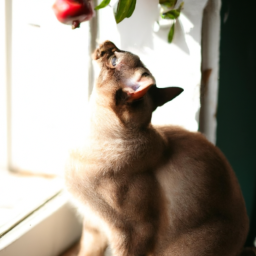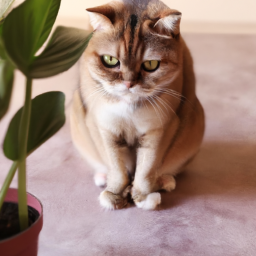
Are you a cat lover who also enjoys having indoor plants in your home? If so, you may have wondered whether these two interests can peacefully coexist. Indoor plants and cats are a common combination, but it’s important to consider the safety of your feline friend when introducing greenery into your living space. In this blog post, we will explore the relationship between indoor plants and cats, discussing which plants are safe for your furry companion and how to create a cat-friendly environment that allows you to enjoy the beauty of nature indoors. So, let’s dive in and discover how you can keep both your plants and your cats happy and healthy in your home!
The Best Indoor Plants that are Safe for Cats
As a cat owner, it’s important to create a safe and engaging environment for your furry friend. Indoor plants not only add beauty and freshness to your home but can also provide entertainment for your curious feline. However, not all plants are safe for cats, as some can be toxic and cause harm if ingested. In this guide, we will explore the best indoor plants that are safe for cats, ensuring a harmonious and pet-friendly living space.
1. Spider Plant (Chlorophytum comosum)
The Spider Plant is a popular choice among cat owners due to its non-toxic nature. This plant features long, arching leaves with white stripes, making it an attractive addition to any indoor space. Cats are often intrigued by the dangling baby spiderettes, providing them with a source of entertainment.
Spider plants are easy to care for and thrive in various light conditions, making them suitable for different areas of your home. They can tolerate some neglect and are forgiving if you forget to water them occasionally. However, it’s always best to keep an eye on your cat’s interactions with the plant to ensure they don’t chew on the leaves excessively.
If you notice your cat showing excessive interest in the Spider Plant, you can consider hanging it from a ceiling hook or placing it on a high shelf to keep it out of their reach. This will allow your cat to enjoy the plant without the risk of ingestion.
2. Boston Fern (Nephrolepis exaltata)
The Boston Fern is not only a beautiful addition to your indoor garden but is also safe for your feline companion. Its feathery fronds create a lush, green display that adds a touch of elegance to any room. Cats are generally not attracted to Boston Ferns, making them a low-risk option for plant-loving pet owners.
These ferns thrive in bright, indirect light and prefer a humid environment. Regular misting or placing the plant on a tray filled with water and pebbles can help maintain the required humidity levels. Ensure the soil remains consistently moist but not waterlogged.
If your cat does show interest in the Boston Fern, it’s important to monitor their behavior. Some cats may be tempted to chew on the fronds, which can lead to an upset stomach or vomiting. In such cases, it’s advisable to keep the plant in a location that is inaccessible to your furry friend.
3. Areca Palm (Dypsis lutescens)
The Areca Palm, also known as the Butterfly Palm, is a pet-friendly plant that can add a tropical touch to your indoor space. Its feathery, arching fronds create a sense of tranquility and can help improve air quality by filtering toxins from the surrounding environment.
Areca Palms thrive in bright, indirect light and require well-draining soil. They prefer moderate watering, allowing the top inch of soil to dry out before re-watering. It’s important to note that overwatering can lead to root rot, so ensure the plant’s pot has proper drainage.
While the Areca Palm is generally safe for cats, it’s always wise to observe your pet’s behavior around the plant. Some cats may be tempted to chew on the fronds, which can cause an upset stomach or potential blockage. If your cat shows excessive interest, consider using deterrents or placing the plant in an area that is out of reach.
In conclusion, creating a safe and cat-friendly environment involves carefully selecting indoor plants that are non-toxic and monitoring your pet’s interactions with them. The Spider Plant, Boston Fern, and Areca Palm are excellent choices for cat owners, providing both aesthetic appeal and peace of mind. Remember to always research any new plants before introducing them into your home, and consult your veterinarian if you suspect your cat has ingested a toxic plant. With the right precautions and plant choices, you can create an indoor oasis that both you and your feline companion can enjoy.

Indoor Plants and Cats
How to Keep Cats Away from Indoor Plants
Cats are curious creatures, and their love for exploring can sometimes lead them to mischief, especially when it comes to indoor plants. If you are a cat owner and also enjoy having indoor plants, it’s important to find ways to keep your feline friends away from your greenery. In this guide, we will explore effective methods to deter cats from your indoor plants.
Understanding the Attraction
Before we dive into the solutions, it’s essential to understand why cats are drawn to indoor plants in the first place. Cats are instinctively attracted to the texture, smell, and movement of plants. They may see your plants as a playground or a source of entertainment. Additionally, some plants are mildly toxic to cats, and their nibbling can lead to health issues. By addressing these factors, we can create a cat-friendly environment while ensuring the safety of our plants and pets.
1. Choose Cat-Safe Plants: Start by selecting indoor plants that are non-toxic to cats. Some popular options include spider plants, Boston ferns, and Swedish ivy. These plants are not only safe for your feline friends but also add beauty to your home. Avoid toxic plants like lilies, aloe vera, and pothos, as ingestion can cause severe health problems for cats.
2. Create a Distraction: Cats often seek stimulation, so providing them with alternative sources of entertainment can divert their attention from your plants. Set up a designated play area with interactive toys, scratching posts, and climbing structures. By keeping your cats engaged, they are less likely to be interested in your indoor plants.
3. Utilize Scent Deterrents: Cats have a strong sense of smell, and certain scents can repel them from your plants. Citrus fruits, such as oranges or lemons, are known to be disliked by cats. Place citrus peels around the base of your plants or use citrus-scented sprays to create a natural deterrent. Additionally, you can try using diluted essential oils like lavender or eucalyptus, as cats tend to dislike these scents.
Physical Barriers and Training Methods
If your cats are persistent plant explorers, implementing physical barriers and training techniques can help keep them away from your indoor plants.
1. Use Chicken Wire or Mesh: Create a barrier around your plants using chicken wire or mesh. This will prevent your cats from accessing the plants directly, while still allowing sunlight and airflow. Ensure the barrier is tall enough to deter jumping or climbing attempts.
2. Place Aluminum Foil or Double-Sided Tape: Cats dislike the texture of aluminum foil and sticky surfaces. Cover the soil or place strips of foil around the base of your plants. Alternatively, use double-sided tape on the edges of your pots. The unpleasant sensation will discourage your cats from approaching the plants.
3. Train with Positive Reinforcement: Positive reinforcement training can be an effective way to teach your cats to stay away from your plants. Whenever you catch your cat showing interest in the plants, redirect their attention to a toy or treat. Reward them for engaging with the desired object instead of the plants. With consistency and patience, your cats will learn to associate the plants with a lack of reward.
Additional Tips for Success
Here are a few additional tips to ensure the success of keeping your cats away from your indoor plants:
1. Provide Sufficient Environmental Enrichment: Ensure your cats have enough mental and physical stimulation to prevent boredom. Play with them regularly, offer scratching posts, and create vertical spaces for climbing. A well-enriched environment reduces the likelihood of your cats seeking entertainment in your plants.
2. Regularly Trim and Prune Your Plants: Cats are more attracted to plants with dangling leaves or vines. Regularly trim and prune your plants to remove tempting foliage that may entice your feline friends.
3. Use Repellent Sprays: Commercial cat repellent sprays are available in pet stores. These sprays usually contain natural ingredients that are safe for both plants and cats. Follow the instructions on the packaging to apply the spray to your plants and deter your cats.
Remember, consistency and patience are key when training your cats to stay away from your indoor plants. By implementing a combination of these strategies, you can create a harmonious environment where both your plants and cats can thrive.

Benefits of Indoor Plants for Cats’ Health and Well-being
As a cat owner, you may be wondering how indoor plants can positively impact your feline friend’s health and well-being. Indoor plants not only add beauty and freshness to your home, but they can also provide numerous benefits for your cat’s physical and mental health. In this guide, we will explore the various ways in which indoor plants can enhance your cat’s overall well-being.
Purifying the Air
One of the significant benefits of indoor plants is their ability to purify the air by removing toxins and releasing oxygen. Cats, just like humans, can be affected by poor indoor air quality, which can lead to respiratory issues and allergies. By introducing indoor plants into your home, you can create a healthier environment for your cat to breathe in.
Plants such as Spider Plant, Boston Fern, and Areca Palm are known for their air-purifying properties. These plants can help filter out harmful chemicals like formaldehyde and benzene, which are commonly found in household products. By reducing the presence of these toxins, you can minimize the risk of respiratory problems in your cat and promote better overall lung health.
It’s important to note that while indoor plants can improve air quality, some plants can be toxic to cats if ingested. Therefore, it’s crucial to research and choose cat-friendly plants to ensure the safety of your furry friend.
Stress Reduction and Mental Stimulation
Indoor plants can also play a significant role in reducing stress and providing mental stimulation for your cat. Cats are natural hunters, and having plants in the indoor environment can mimic the experience of exploring the outdoors. The sight, smell, and texture of plants can engage your cat’s senses and provide them with a source of entertainment and mental enrichment.
Consider incorporating plants with different textures, such as Catnip, Cat Grass, and Cat Thyme. These plants can offer a safe and interactive playtime experience for your cat. Catnip, in particular, contains a compound called nepetalactone, which can induce a state of euphoria in cats, providing them with a natural high. However, not all cats are affected by catnip, so it’s essential to observe your cat’s reaction to determine if it’s suitable for them.
Additionally, having indoor plants can create a calming and soothing environment for your cat. The presence of greenery can help reduce anxiety and promote relaxation, especially for indoor cats who may not have access to outdoor spaces. Providing a stimulating environment can contribute to your cat’s overall well-being and prevent boredom-related behavioral issues.
Improving Indoor Air Humidity
Indoor air humidity is crucial for maintaining optimal respiratory health for both humans and cats. Dry air can lead to dry skin, irritated nasal passages, and increased susceptibility to respiratory infections. Indoor plants can act as natural humidifiers, releasing moisture into the air through a process called transpiration.
Plants such as Boston Fern, Peace Lily, and Areca Palm are excellent choices for increasing indoor humidity levels. These plants have high transpiration rates, which can help combat dry air and create a more comfortable living environment for your cat.
However, it’s essential to strike a balance when it comes to humidity levels. Too much moisture can create a breeding ground for mold and mildew, which can be harmful to both you and your cat. Regularly monitor the humidity levels in your home and adjust plant placement accordingly to maintain optimal humidity without excess moisture.
In conclusion, indoor plants offer numerous benefits for your cat’s health and well-being. From purifying the air to reducing stress and improving indoor air humidity, plants can contribute to a healthier and happier living environment for your feline companion. Remember to choose cat-friendly plants and provide appropriate care to ensure the safety and enjoyment of both you and your cat.
Key Takeaways
Indoor plants are a great way to bring some greenery into your home and create a cozy, natural atmosphere. However, if you have a furry feline friend, you might be concerned about the potential dangers of having plants around. Cats are curious creatures and love to explore their surroundings, which can sometimes lead to them nibbling on plants that may not be safe for them. In this blog post, we will explore some indoor plants that are not only beautiful but also safe for your beloved cat.
One excellent choice for cat-friendly indoor plants is the spider plant. With its long, arching leaves, this plant adds a touch of elegance to any room. The best part is that spider plants are non-toxic to cats, so even if your curious kitty decides to take a bite, there’s no need to worry. Another safe option is the Boston fern, known for its lush, feathery fronds. Not only does this plant purify the air, but it’s also non-toxic to cats, making it a perfect addition to your indoor garden. Additionally, the areca palm, known for its graceful, feather-like leaves, is another cat-friendly choice that can bring a tropical vibe to your home without posing any harm to your furry companion.
By choosing cat-friendly indoor plants, you can create a beautiful and safe environment for both you and your feline friend. Remember to always research the plants you bring into your home to ensure they are safe for your cat, and if in doubt, consult with your veterinarian. With a little bit of planning and consideration, you can enjoy the benefits of indoor plants while keeping your curious kitty out of harm’s way.
Here are this week’s Top Questions and Answers
Q1: Are there indoor plants that are safe for cats?
A1: Yes, there are several indoor plants that are safe for cats. Some examples include spider plants, Boston ferns, and money plants. These plants are non-toxic to cats and can be a great addition to your indoor space.
Q2: What are some common indoor plants that are toxic to cats?
A2: There are certain indoor plants that can be toxic to cats if ingested. Examples include lilies, pothos plants, and peace lilies. It’s important to keep these plants out of your cat’s reach to prevent any potential harm.
Q3: How can I ensure the safety of my cat around indoor plants?
A3: To ensure your cat’s safety around indoor plants, you can take a few precautions. Firstly, research and choose plants that are non-toxic to cats. Secondly, place the plants in areas that are out of your cat’s reach, such as hanging them or using elevated shelves. Lastly, consider providing your cat with alternative options for chewing or playing, such as cat grass or toys, to divert their attention from the plants.
Q4: What are the benefits of having indoor plants for cats?
A4: Indoor plants can provide several benefits for cats. They can help improve air quality by reducing toxins and increasing humidity. Some plants also provide a source of mental stimulation for cats, as they can observe and interact with the plants. Additionally, certain plants, like cat grass, can serve as a safe and natural dietary supplement for cats.
Q5: How do I train my cat to stay away from indoor plants?
A5: Training your cat to stay away from indoor plants can take time and patience. Start by using deterrents like citrus sprays or aluminum foil around the plants to discourage your cat from approaching them. Additionally, provide plenty of alternative options for your cat’s natural instincts, such as scratching posts and interactive toys. Consistency and positive reinforcement, such as rewarding your cat when they avoid the plants, can also help in training them to stay away.
Dr. Olivia Green is a botanist with over two decades of experience in indoor plant cultivation. She holds a Ph.D. in Plant Biology and has dedicated her career to researching plant behavior in controlled environments. Dr. Green is passionate about helping plant enthusiasts master the art of indoor gardening through her extensive knowledge and practical insights.


